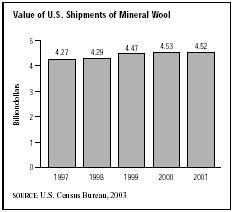SIC 3296
MINERAL WOOL
This category includes companies that make mineral wool and mineral wool insulation products made of such siliceous materials as rock, slag, glass, or combinations of these. Companies that primarily make asbestos insulation products are classified in SIC 3292: Asbestos Products, and those making textile glass fibers are classified in SIC 3229: Pressed and Blown Glass and Glassware, Not Elsewhere Classified.
NAICS Code(s)
327993 (Mineral Wool Manufacturing)
This industry's products include mineral wool acoustical board and tile; fiberglass insulation; glass wool; mineral wool roofing mats; and insulation made of rock wool, slag,

and silica minerals. The value of industry shipments grew relatively steadily throughout the 1980s, from $2.3 billion in 1982 to a peak of $3.4 billion in 1988. However, the mineral wool industry—like others in the United States—was hit hard by a major recession in 1989; by 1991, the industry's value of shipments had fallen to $3.1 billion. By 1997, the industry rebounded with total shipments of $4.27 billion. Shipments climbed steadily throughout the late 1990s, reaching a peak of $4.53 billion in 2000. However, recessionary economic conditions in the early 2000s pushed shipments back to $4.52 billion in 2001.
This industry produced two major product categories: mineral wool for thermal and acoustical envelope insulation, which held 71.6 percent of the market in 2001; and mineral wool for industrial, equipment, and appliance insulation, which accounted for 24.8 percent of the market.
Within the first category, batt, blanket, and roll insulation products had the largest market share; this area includes the familiar fiberglass insulation found in residential attics. Fiberglass insulation used in the upper stories and ceilings of homes varies by type. Acoustical mineral wool holds the next highest market share in the mineral wool industry.
Within the second major category—industrial, equipment, and appliance insulation—sales are spread among four categories: special purpose insulation pieces, other, flexible blankets, and pipe insulation.
Owens-Corning of Toledo, Ohio, was the leading manufacturer of mineral wool, with 2003 sales of $4.9 billion and approximately 18,000 employees. The company was also the leading U.S. maker of industrial asphalt and residential roof shingles. Owens-Corning had more than 80 manufacturing plants worldwide, including four in China.
The next leading company was Knauf Fiberglass of Shelbyville, Indiana, with $140 million in sales and 1,000 employees. Third was CTA Acoustics Inc. of Madison Heights, Michigan, with $100 million in sales and 500 employees.
Employment for the industry remained stable throughout the 1980s, dropping from 19,700 in 1982 to 19,000 in 1990. In 2000, the mineral wool industry had a payroll of $873 million, and more than 21,000 people worked in the industry.
Further Reading
Bureau of Labor Statistics. Employment Statistics. Washington, D.C.: GPO, 2000. Available from http://www.bls.gov .
U.S. Census Bureau. "Statistics for Industry Groups and Industries: 2000." February 2002. Available from http://www.census.gov/prod/2002pubs/m00as-1.pdf .
——. "Value of Shipments for Product Classes: 2001 and Earlier Years." December 2002. Available from http://www.census.gov/prod/2003pubs/m01as-2.pdf .
Comment about this article, ask questions, or add new information about this topic: